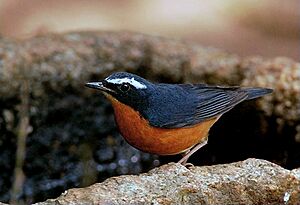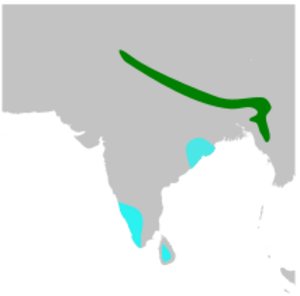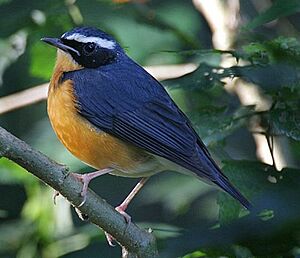Indian blue robin facts for kids
Quick facts for kids Indian blue robin |
|
|---|---|
 |
|
| Conservation status | |
| Scientific classification | |
| Genus: |
Larvivora
|
| Species: |
brunnea
|
 |
|
| Breeding area in green and wintering areas in blue | |
| Synonyms | |
|
Erithacus brunneus |
|
The Indian blue robin (Larvivora brunnea) is a small, colorful bird. You can find it in the Indian Subcontinent. It used to be called a thrush, but now scientists say it's an Old World flycatcher. It belongs to the family Muscicapidae.
This bird is a traveler! It's a migratory species. It spends its summers breeding in the forests of the Himalayas. This includes places like Nepal, India, Myanmar, and Bangladesh. When winter comes, it flies south. It spends the colder months in the hill forests of the Western Ghats in India and in Sri Lanka.
Contents
Understanding the Indian Blue Robin's Name
Scientists give every living thing a special name. This helps everyone know exactly which animal they are talking about. This system is called taxonomy.
The Indian blue robin was first described by a scientist named Hodgson in 1837. He put it in a new group called Larvivora. Later, it was moved to a different group called Luscinia.
However, in 2010, scientists did a big study. They looked closely at the bird's DNA. They found that the Luscinia group wasn't quite right. So, the Indian blue robin was moved back to the Larvivora group. This shows how science helps us learn more about the natural world!
What Does the Indian Blue Robin Look Like?
The Indian blue robin is about 15 centimeters (6 inches) long. This is about the same size as a bluethroat.
The adult male bird is very striking. Its upper body is a bright blue color. Its belly and chest are a warm reddish-orange. It has a bright white stripe above its eye. This white stripe stands out against a black patch that covers its face and goes down its neck. The lower part of its belly and the feathers under its tail are whitish.
The female Indian blue robin looks a bit different. Her upper body is olive-brown. Her underside is a light yellowish-brown, called buff. She has a light ring around her eye. Her rump (the area above her tail) has a reddish tint. Her chest and sides are also buffy.
Young Indian blue robins look different from their parents. They are dark brown with small buff-colored spots.
Where Do Indian Blue Robins Live and Travel?
The main group of Indian blue robins breeds, or has its babies, from eastern Afghanistan all the way to the eastern Himalayas. There's another group, called wickhami. These birds breed in the Chin Hills of western Myanmar. Scientists believe this group does not migrate.
These birds are known for their long journeys. They arrive in the Himalayan breeding areas around May. They stay there until September. Their trip south for winter starts in August. During this time, you might see them passing through other parts of India.
In winter, they mostly live in the hill forests of southern India. This includes the Western Ghats and Sri Lanka. They usually arrive in their winter homes by mid-September. They leave these areas in mid-April to fly back north.
Scientists have noticed something interesting. In some wintering areas, there seem to be more males than females. This might mean that males and females travel at different times. Or, they might spend winter in slightly different places.
Life and Habits of the Indian Blue Robin
The Indian blue robin mainly eats insects. It finds its food on the ground. This bird likes to stay hidden in thick bushes and undergrowth. It hops around on the ground. You might see it flicking and fanning its tail often.
Reproduction and Nesting
The breeding season for these birds is from May to July. They build a large, cup-shaped nest. They make it from plants and place it on the ground. You might find a nest between the roots of a big fir tree or in a small dip in the ground. The inside of the nest is soft. It's lined with roots, hair, and soft down.
A female Indian blue robin usually lays about four light blue eggs. Scientists believe only the female sits on the eggs to keep them warm. However, both the male and female parents help feed the baby birds once they hatch.
Sometimes, another bird called the cuckoo (Cuculus canorus) lays its eggs in the robin's nest. This is called brood parasitism. The cuckoo tricks the robin into raising its young!
Migration and Habitat
The Indian blue robins arrive in their Himalayan breeding grounds in May. They leave in September. Their journey south for winter starts in August. During migration, you might see them in many parts of India.
In winter, they are mostly found in the hill forests of southern India. This includes the Western Ghats and Sri Lanka. They arrive in mid-September and leave their winter homes in mid-April.
These birds prefer to live in dense, dark forests. They like places with lots of undergrowth and fallen leaves on the ground.
Song and Calls
Even in their winter homes, these birds sing and call. Their song is a sudden and sharp series of whistles. It ends with many fast notes. They also make a sharp, low clicking sound. This is often an alarm call if they sense danger.



